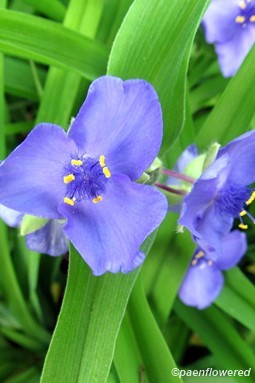Tradescantia virginiana
Tradescantia virginiana Virginia spiderwort
This native perennial wildflower is a member of the spiderwort family. There are three stories concerning the common name of this plant. The most common explanation is the resemblance the angular arrangement of the leaves to a squatting spider. The name may also be based on secretions from the cut stem turn threadlike and resemble spider silk or the purple silk like threads in the center of the flower.
The plant can grow between eight and twenty-four inches high. The flowers form one or two at a time from a terminal cluster of buds and are one to two inches in diameter. They are usually blue in color but violet and even white examples are known. Three gold stamens accent the color of the flower. A few flowers bloom each morning. Later in the day they wilt and the petals turn into a jelly-like substance. Each of the hairs on the stamen consists of a chain of single cells. These hairs are popular with biology teachers because, under a microscope, flowing cytoplasm and the nucleus are clearly visible.
The plant blooms between April and July on wood edges, in thickets, along roadsides, in meadows or wherever there is sufficient moisture. There is no floral scent. Bumblebees are the major pollinating insects. The leaves of the spiderwort are long and Iris-like, and are folded lengthwise to form a channel. This species is found in the Eastern United States and California. There are several other species found locally in the east (Ohio and zig-zag spiderwort) and in western United States, but the Virginia spiderwort is the most common.
It is a popular garden plant, though many of those found commercially are hybrids of the Virginia spiderwort and some other spiderwort species. Often it is difficult to tell the wild variety from the hybrid escapees. It is also called lady’s tears.
Habitat & Range
Occasional on wooded slopes, shaled outcrops, moist fields, and along roadsides.
Mostly found in the southern part of the state.
| EMP: | FACU |
|---|---|
| NCNE: | UPL |
Phenology
Flowers late April through June.
Plant Codes
S-rank: No rank
G-rank: G5 (Secure)






Comments
Have you spotted this plant in your area? We'd love to hear about your experience! Share your comments or questions about the plant below. Comments are moderated before posting.